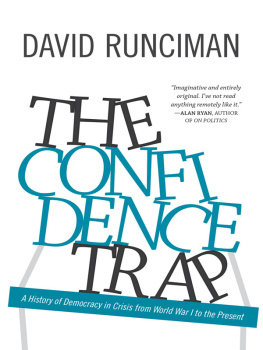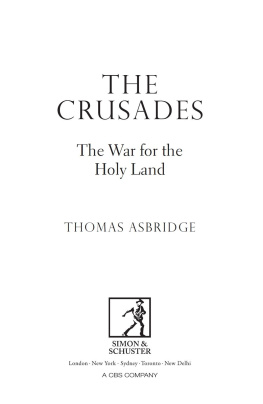A HISTORY OF
THE CRUSADES
VOLUME III
THE KINGDOM OF ACRE
and the Later Crusades
BY
STEVEN RUNCIMAN
CAMBRIDGE
UNIVERSITY PRESS
Published by the Press Syndicate of theUniversity of Cambridge
The Pitt Building, Trumpington Street,Cambridge CB2 IRP
40 West 20th Street, New York, NY10011-4211, USA
10 Stamford Road, Oakleigh, Melbourne3166, Australia
Cambridge University Press 1951
First published in hardback 1951
First published in paperback by CambridgeUniversity Press 1987
Reprinted 1951, 1953, 1954, 1957, 1962,1968, 1975, 1980, 1987, 1988, 1989, 1990, 1993, 1995
Printed in the United States of America
Library of Congress catalog card number:75-10236
Volume I: ISBN 0 521 06161 x hardback
ISBN 0 521 34770 x paperback
Volume II: ISBN 0 521 06162 8 hardback
ISBN 0 521 34771 8 paperback
Volume III: ISBN 0 521 06163 6 hardback
ISBN 0 521 34772 6 paperback
Set of three volumes: ISBN 0 521 20554 9hardback
ISBN 0 521 35997 x paperback
Paperback editions for sale in USA only
To
KATHARINE FARRER
CONTENTS
ListofPlates
ListofMaps
Preface
BOOK I
THE THIRD CRUSADE
I TheConscience of the West
II Acre
III Coeur-de-Lion
IV TheSecond Kingdom
BOOK II
MISGUIDED CRUSADES
I TheCrusade against Christians
II TheFifth Crusade
III TheEmperor Frederick
IV LegalizedAnarchy
BOOK III
THE MONGOLS AND THE MAMELUKS
I TheComing of the Mongols
II SaintLouis
III TheMongols in Syria
IV SultanBaibars
BOOK IV
THE END OF OUTREMER
I TheCommerce of Outremer
II Architectureand the Arts in Outremer
III TheFall of Acre
BOOK V
EPILOGUE
I TheLast Crusades
II TheSumming-Up
Appendix
II IntellectualLife in Outremer
III GenealogicalTrees
1. The Royal Houses ofJerusalem and Cyprus and the House of Ibelin
2. The Princely House ofAntioch
3. The House of Embriaco
4. The Royal House of Armenia(Cilicia)
5. The Ayubite House
6. The House of Jenghiz Khan
LIST OF PLATES
I TheEmperor Frederick Barbarossa and his sons, Henry VI, King of the Romans, andFrederick, Duke of Swabia (From the Fulda manuscript of the HistoriaWelforum)
II Constantinoplefrom the Asiatic Coast (From Beauties of the Bosphorus, London, n.d.)
III Viewof Tyre (David Roberts, 1839)
IV Sidon(From Syria Illustrated, by Bartlett, Allom, etc., Vol. III, London,1838)
V TheIlkhan Hulagu (From British Museum MS. Add. 18803)
VI Krakdes Chevaliers, from the air (Photograph supplied by Institut Francais dArcheologie,Beirut)
VII TheChoir of the Church of the Holy Sepulchre in 1681 (From Corneille le Bruyn, Voyagein the Levant, London, 17oz)
VIII TheCathedral of Tortosa (From Les Monuments des Croises, by C. Enlart, pub.Geuthner, Paris, 1926-7)
IX Mosaicpanel of Christ in Glory, from the vault of the Latin chapel of Calvary (FromW. Harvey, Church of the Holy Sepulchre, Oxford, 1933)
X TheChurch of St Andrew at Acre in 1681 (From Voyage in the Levant)
XI TheTemptation (From the Psalter called of Queen Melisende, British Museum MS.Egerton 1139)
XII Transfiguration(From the same)
XIII Virginand Child, Enthroned (From the same)
XIV Plan ofAcre (From Marino Sanudo, Secreta Fidelium Crucis, Bodleian MS. Tanner190)
XV MamelukEmirs about the end of the thirteenth century (From D. S. Rice, LeBaptistere de Saint Louis, pub. Les Editions du Chene, Paris, 1951)
LIST OF MAPS
1 Environsof Acre in 1189
2 TheNile Delta at the time of the Fifth Crusade and the Crusade of St Louis
3 TheMongol Empire under Jenghiz Khan and his successors
4 Acrein 1291
5 Outremerin the thirteenth century
PREFACE
This volume is intended to cover the history of Outremerand the Holy Wars from the revival of the Frankish kingdom at the time of theThird Crusade till its collapse a century later, with an epilogue on the last manifestationsof the Crusading spirit. It is a story with several interwoven themes. Thedecline of Outremer, with its petty but complex tragedies, was periodicallyinterrupted by great Crusades, all of which, after the Third, closed indiversion or disaster. In Europe, though it was still usual for every potentateto pay lip-service to the Crusading movement, not even the fervent piety ofSaint Louis could arrest its decline, while the growing enmity between Easternand Western Christendom reached its climax in the greatest tragedy of theMiddle Ages, the destruction of Byzantine civilization in the name of Christ.In the Moslem world the constant stimulus of the Holy War resulted in thereplacement of the kindly and cultured Ayubites by the more efficient and lesssympathetic Mameluks, whose Sultans were to eliminate Frankish Syria. Finally,there was the arbitrary irruption of the Mongols, whose coming seemed at firstlikely to rescue Eastern Christendom but whose influence in the end, throughthe mishandling and misunderstanding of their potential allies, was onlydestructive in its effects. The whole tale is one of faith and folly, courageand greed, hope and disillusion.
I have included short chapters on the commerce and the artsof Outremer. The treatment is necessarily perfunctory; for neither thecommercial nor the artistic history of a colonial state such as Outremer can bedetached from the general history of medieval trade and civilization. I havetherefore tried to confine myself within limits that are strictly relevant tothe understanding of Outremer.
The history of the Crusades is a large subject with undefinedfrontiers; and the treatment that I have given to it represents my own personalchoice. If readers consider that the emphasis that I have given to its variousaspects is wrong, I can only plead that an author must write his book in hisown way. It is beside the point for critics to complain that he has not writtenthe book that they would have written had they undertaken the theme. But I hopethat I have not entirely omitted anything that is essential to itscomprehension.
The large debts that I owe to many scholars, dead andliving, are, I think, apparent in my footnotes. Sir George Hills great historyof Cyprus and Professor Atiyas meticulous history of the Later Crusades areboth essential for the study of the period; and students must be permanentlygrateful to Professor Claude Cahen for the learned information contained in hisworks. I must mention with regret the death of M. Grousset, whose broad visionand lively writing did much to elucidate the politics of Outremer and theAsiatic background. I have again been largely dependent on the work of Americanscholars, such as the late Professor La Monte, and Mr P. A. Throop.
Once again I must thank my friends in the Near East, whohave helped me during my travels there, in particular the Iraq PetroleumCompany; and the Syndics of the Cambridge University Press for their kindness.
STEVEN RUNCIMAN
LONDON1954
BOOK I
THE THIRD CRUSADE
CHAPTER I
THE CONSCIENCE OF THE WEST
The kings of the earth, andall the inhabitants of the world, would not have believed that the adversaryand the enemy should have entered into the gates of Jerusalem. LAMENTATIONS IV, 12
Bad news travels fast. The battle ofHattin had hardly been fought and lost before messengers hurried westward toinform the princes of Europe; and they were soon followed by others telling ofthe fall of Jerusalem. Western Christendom learned of the disasters withconsternation. In spite of all the appeals that had come from the kingdom ofJerusalem in recent years, no one in the West, except perhaps at the PapalCourt, had realized the urgency of the danger. The knights and pilgrims thathad journeyed eastward had found in the Frankish states a life more luxuriousand gay than any that they had known at home. They heard tales of militaryprowess; they saw commerce flourishing. They could not comprehend howprecarious was all this prosperity. Now, suddenly, they heard that it was allended. The Christian army had been destroyed; the Holy Cross, most sacred ofthe relics of Christendom, was in the hands of the infidel; and Jerusalemitself was taken. In the spare of a few months the whole edifice of theFrankish East had collapsed; and if anything was to be rescued from the ruins,help must be sent, and sent quickly.
Next page













